Indonesia Power Market Size
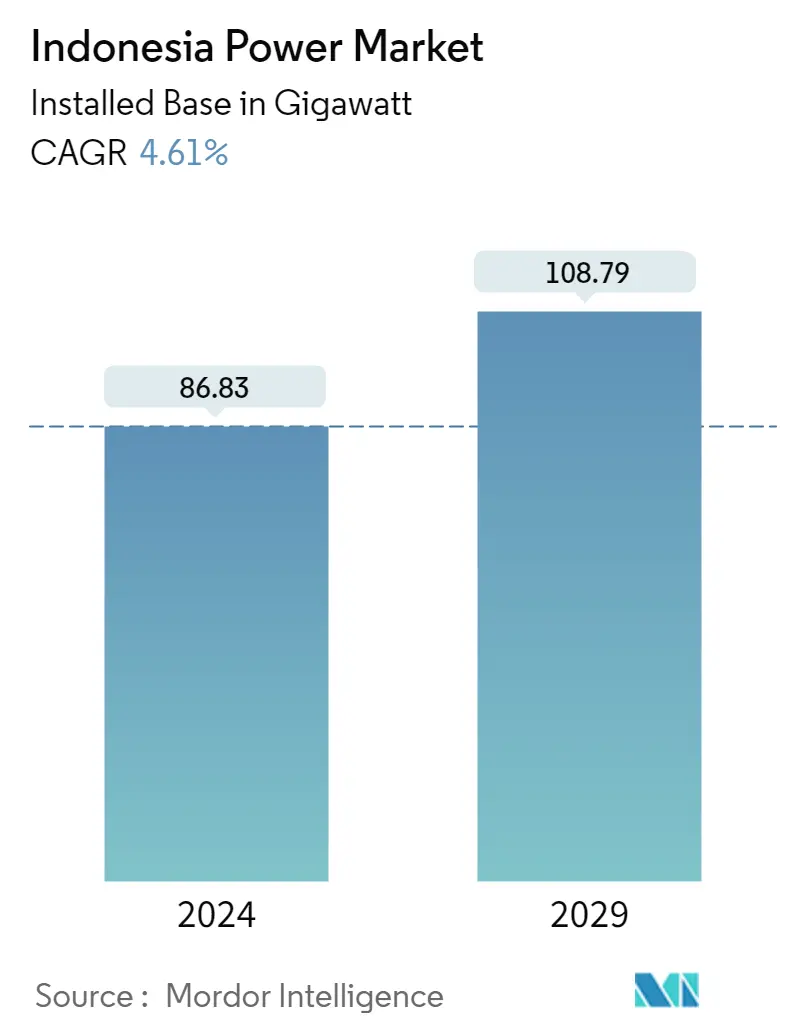
| Study Period | 2019 - 2029 |
| Base Year For Estimation | 2023 |
| Market Volume (2024) | 86.83 gigawatt |
| Market Volume (2029) | 108.79 gigawatt |
| CAGR (2024 - 2029) | 4.61 % |
| Market Concentration | Medium |
Major Players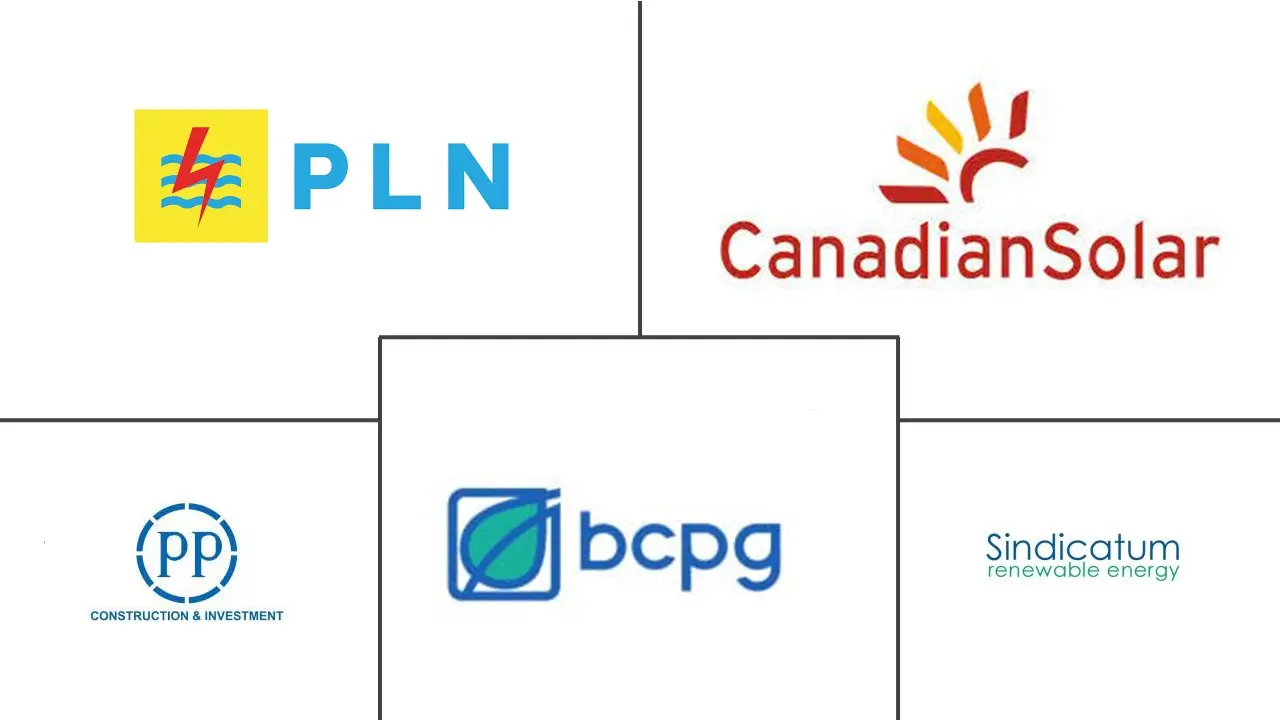
*Disclaimer: Major Players sorted in no particular order |
Indonesia Power Market Analysis
The Indonesia Power Market size in terms of installed base is expected to grow from 86.83 gigawatt in 2024 to 108.79 gigawatt by 2029, at a CAGR of 4.61% during the forecast period (2024-2029).
- Over the medium term, factors such as increasing renewable energy power plants and increasing work in the transmission and distribution sectors are likely to drive the market.
- On the other hand, high levels of rebellion from the people living near new conventional thermal power plants due to pollution are expected to slow down the Indonesian power market.
- Nevertheless, the Indonesian Government has set a target to achieve net-zero emissions by 2060, which will present significant opportunities to players involved in the power generation as well as transmission and distribution sectors in the market.
Indonesia Power Market Trends
Coal-based Power Generation to Dominate the Market
- Indonesia is a Southeast Asian country that relies heavily on coal-based power generation due to the significant presence of coal mines.
- According to the Energy Institute Statistical Review of World Energy 2023, as of 2022, coal-based electricity generation had a share of close to 61.5% of the Indonesian electricity generation mix.
- This reliance on coal-based power plants comes from the coal mining industry in Indonesia. According to Ministry of Energy and Mineral Resources (Indonesia), the country produced around 687.43 million metric tons of coal in 2022, an increase of around 12% in coal production as compared to 2021, i.e., 613.99 million metric tons.
- According to Global Energy Monitor, as of January 2023, Indonesia had coal-fired power plants with an installed capacity of 40.64 GW and 18.84 GW under construction.
- Although the Indonesian government plans to stop building new coal power plants in 2023, it will still allow the construction of already approved power plants. Coal-based power plants have an operational life of several decades and will eat up the potential space of renewable energy power plants.
- Due to the above-mentioned points, it is expected that coal-based power generation will dominate the market during the forecast period.
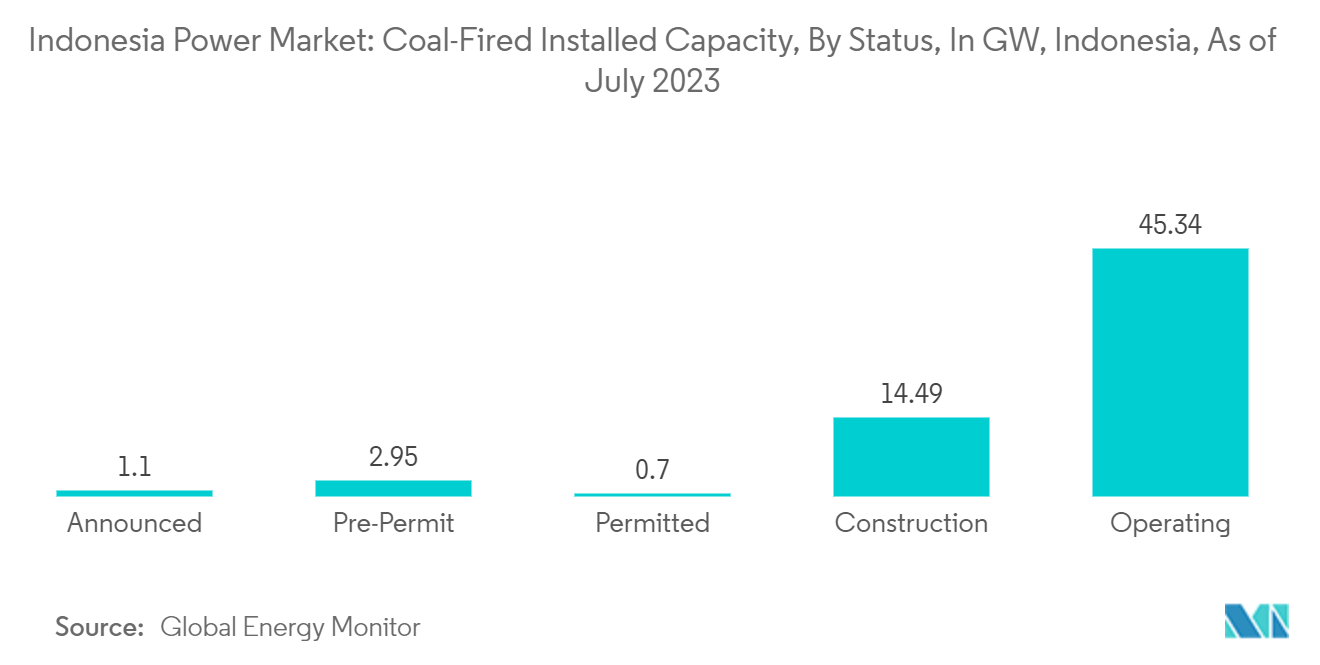
Upcoming Renewable Projects to Drive the Market
- The Indonesian government set a renewable energy target of 23% and 31% of total electricity generation by 2025 and 2050, respectively. Currently, around 13% of power generation nationwide comes from renewable energy resources, mainly hydroelectric and geothermal power production. As a result, the country is witnessing several upcoming projects. According to the International Renewable Energy Agency, as of 2022, Indonesia installed renewable energy capacity of 12.48 GW, and it is expected to increase further in the forecast period.
- As per the International Hydropower Association, hydropower potential in Indonesia is around 75 GW having untapped resources located at Java, Sumatra, and Sulawesi islands. Hydropower is touted to be the key enabler for the clean energy transition. In 2022, PLN started the construction of a 1,040 MW of hydropower plant worth USD 850 million in West Java to accelerate electricity generation by renewable energy in the country.
- Further, the government has targeted the installation of 5 GW of geothermal capacity by 2025. As per the general plan for national energy (RUEN), about 7.24 GW of geothermal power is planned to get installed by 2025 and 9.3 GW by 2035, indicating utilization of the same on a wide scale.
- Solar PV systems offer competitive electricity prices, with swift installation and short construction time of the plant’s infrastructure. This makes them the most preferred viable alternative over other technologies, such as biomass. Considering the benefits offered by solar PV, the government of Indonesia drafted new regulations to promote the same to meet renewable energy targets.
- In March 2022, Beiersdorf AG, the German skincare product maker of the Nivea brand, entered a long-term solar power deal with French multi-energy group TotalEnergies SE involving a rooftop project in Indonesia. TotalEnergies plans to install a 540-kWp solar PV array on a Beiersdorf manufacturing site to generate some 830 MWh of electricity per year.
- In March 2022, Sungrow Power Supply Co. Ltd. signed a 300 MW strategic partnership agreement with Indonesian solar rooftop specialist Utomo SolaRUV to expand its sales in the Indonesian market.
- Therefore, such projects in the pipeline are likely to drive the Indonesian power market during the forecast period.
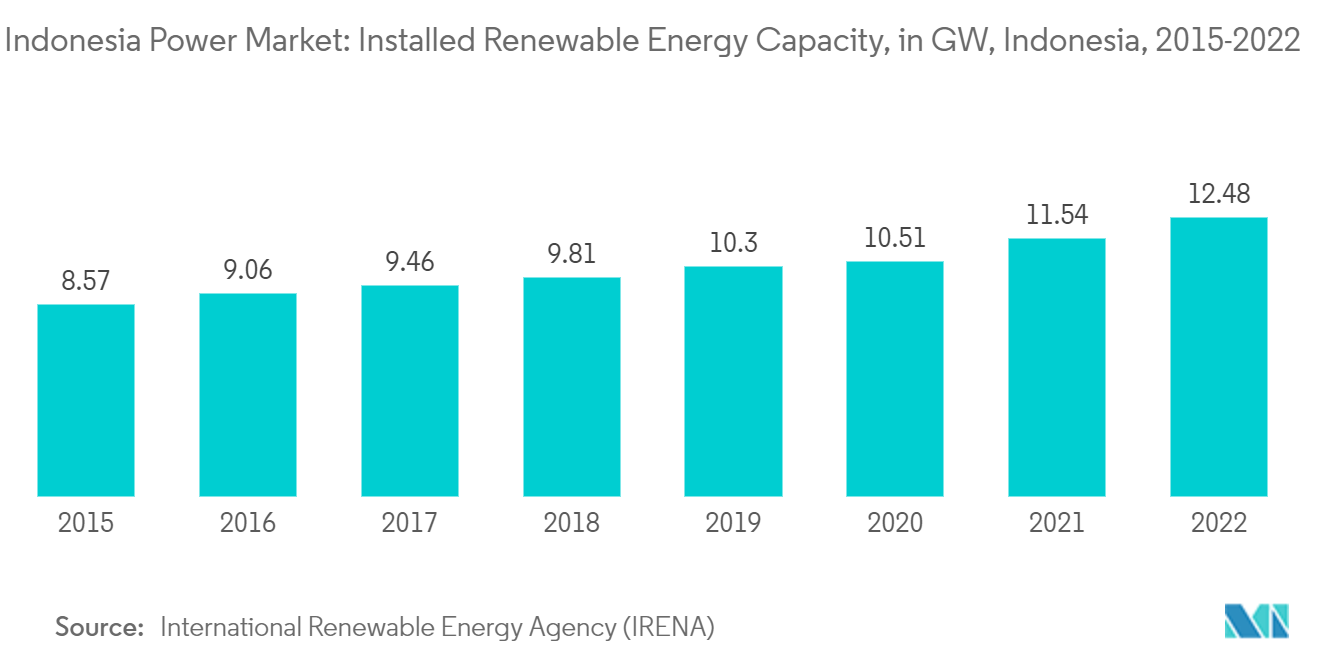
Indonesia Power Industry Overview
The Indonesian power market is moderately consolidated. Some of the major players involved in the market (in no particular order) include PT Perusahaan Listrik Negara, CanadianSolar Inc., PT PP Persero Tbk, BCPG Public Company Limited, and Sindicatum Renewable Energy Company Pte Ltd., among others.
PT Perusahaan Listrik Negara aims to produce 23% of its electricity through renewable energy sources by 2025. Thus, to achieve this, the company has laid out plans for co-firing biomass in its coal power plants to generate electricity and consequently increase its share of clean energy.
Due to the monopoly on the country's electric sector, the company has a strong market position enabling it to work with some of the biggest electricity power generation companies worldwide. This gives the company a strong competitive edge compared to other market players in the country.
For instance, in November 2022, the company signed a memorandum of understanding (MoU) with Mitsubishi Heavy Industries to perform feasibility studies of co-firing 100% biomass in its coal power plants. Moreover, the MoU further includes developing efficient techniques for biomass energy generation. These collaborations with leading global players maintain the company's strong position in the market.
Indonesia Power Market Leaders
-
Sindicatum Renewable Energy Company Pte Ltd
-
CanadianSolar Inc.
-
PT Perusahaan Listrik Negara
-
BCPG Public Company Limited
-
PT PP Persero Tbk
*Disclaimer: Major Players sorted in no particular order
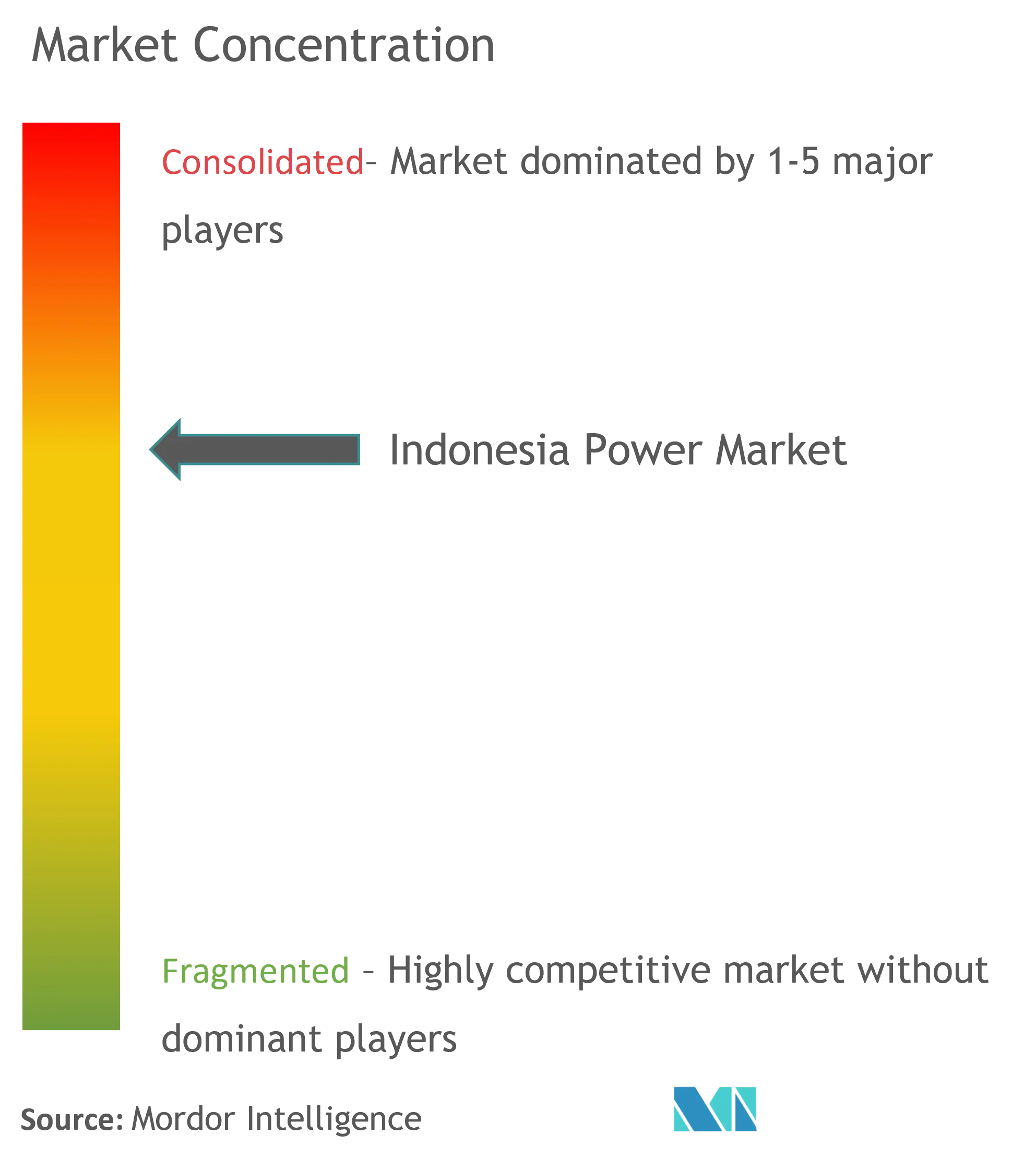
Indonesia Power Market News
- March 2023: Mitsubishi Heavy Industries, Ltd. and PT. PLN Nusantara Power, a sub-holding of Indonesia's state-owned electricity provider PT. PLN (Persero) (PLN) signed an agreement to start off three technical studies related to co-firing of less carbon-intensive fuels at power plants owned and operated by Nusantara Power.
- November 2022: ACWA Power Company announced that PT Perusahaan Listrik Negara (Persero), Indonesia's sole state-owned electricity utility chose the company to develop two floating solar PV projects. The company's first venture into Southeast Asia as well as its first floating solar PV project are being built by ACWA Power. The facilities will be named the Saguling Floating Solar PV Project and the Singkarak Floating Solar PV Project, and will each have an installed capacity of 60 MWac and 50 MWac, respectively, and represent a combined investment value of USD 105 million.
Indonesia Power Market Report - Table of Contents
1. INTRODUCTION
1.1 Scope of the Study
1.2 Market Definition
1.3 Study Assumptions
2. RESEARCH METHODOLOGY
3. EXECUTIVE SUMMARY
4. MARKET OVERVIEW
4.1 Introduction
4.2 Installed Power Capacity and Forecast in GW, till 2028
4.3 Electricity Generation and Forecasts in TWh, till 2028
4.4 Recent Trends and Developments
4.5 Government Policies and Regulations
4.6 Market Dynamics
4.6.1 Drivers
4.6.2 Restraints
4.7 Supply Chain Analysis
4.8 PESTLE Analysis
5. MARKET SEGMENTATION
5.1 Power Generation Source
5.1.1 Oil and Natural Gas
5.1.2 Coal
5.1.3 Hydroelectricity
5.1.4 Renewables
5.2 Power Transmission and Distribution
6. COMPETITVE LANDSCAPE
6.1 Merger and Acquisition, Joint Ventures, Collaborations, and Agreements
6.2 Strategies Adopted by the Leading Players
6.3 Company Profiles
6.3.1 PT Perusahaan Listrik Negara
6.3.2 Fuji Electric Company
6.3.3 Harbin Power Engineering
6.3.4 PT Indika Energy Tbk
6.3.5 Mitsubishi Power Ltd
6.3.6 PT Pertamina Geothermal Energy
6.3.7 PT PP Persero Tbk
6.3.8 Canadian Solar Inc.
6.3.9 BCPG Public Company Limited
6.3.10 Sindicatum Renewable Energy Company Pte Ltd
- *List Not Exhaustive
7. MARKET OPPORUNITIES AND FUTURE TRENDS
Indonesia Power Industry Segmentation
Power generation is the generation of electricity through various primary sources such as coal, hydro, solar, thermal, etc. In utilities, it's a step prior to its delivery to end users. The process is followed by transmission and distribution. Under this, the power generated is distributed via high-voltage lines (transmission lines) and low-voltage lines (distribution lines) as per the requirements of the end user.
Indonesia's power market is segmented by power generation source, power transmission and distribution. By power generation source, the market is segmented into oil and natural gas, coal, and renewables. For each segment, market sizing and forecasts have been done based on installed capacity in gigawatts (GW).
| Power Generation Source | |
| Oil and Natural Gas | |
| Coal | |
| Hydroelectricity | |
| Renewables |
Indonesia Power Market Research FAQs
How big is the Indonesia Power Market?
The Indonesia Power Market size is expected to reach 86.83 gigawatt in 2024 and grow at a CAGR of 4.61% to reach 108.79 gigawatt by 2029.
What is the current Indonesia Power Market size?
In 2024, the Indonesia Power Market size is expected to reach 86.83 gigawatt.
Who are the key players in Indonesia Power Market?
Sindicatum Renewable Energy Company Pte Ltd, CanadianSolar Inc., PT Perusahaan Listrik Negara, BCPG Public Company Limited and PT PP Persero Tbk are the major companies operating in the Indonesia Power Market.
What years does this Indonesia Power Market cover, and what was the market size in 2023?
In 2023, the Indonesia Power Market size was estimated at 83 gigawatt. The report covers the Indonesia Power Market historical market size for years: 2019, 2020, 2021, 2022 and 2023. The report also forecasts the Indonesia Power Market size for years: 2024, 2025, 2026, 2027, 2028 and 2029.
Indonesia Power Industry Report
Statistics for the 2024 Indonesia Power market share, size and revenue growth rate, created by Mordor Intelligence™ Industry Reports. Indonesia Power analysis includes a market forecast outlook to 2029 and historical overview. Get a sample of this industry analysis as a free report PDF download.



